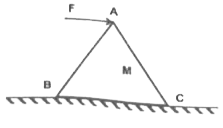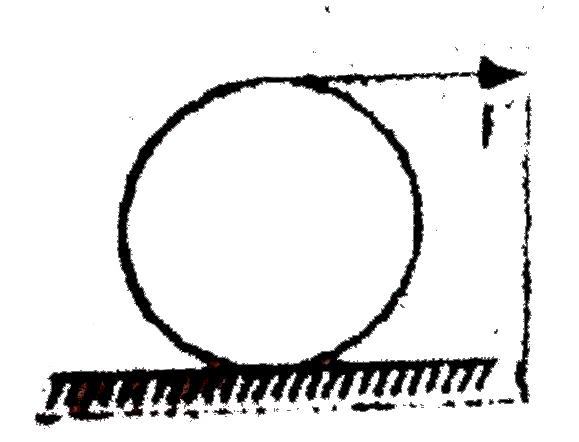A constant horizontal force (F) is applied at the vertex A of an equilateral triangular wedge ABC of mass M and side length AB=BC=CA=l1 placed on a rough horizontal surface as shown in the figure. Even after the application of force F the wedge remains stationary. Calculate the torque of normal reaction acting between the wedge and the floor about the vertex B.

The correct Answer is:(Mg+√3F)l2
Step by step video, text & image solution for A constant horizontal force (F) is applied at the vertex A of an equilateral triangular wedge ABC of mass M and side length AB=BC=CA=l_(1) placed on a rough horizontal surface as shown in the figure. Even after the application of force F the wedge remains stationary. Calculate the torque of normal reaction acting between the wedge and the floor about the vertex B. by Physics experts to help you in doubts & scoring excellent marks in Class 12 exams.
Updated on:21/07/2023Topper's Solved these Questions
- KINEMATICSBOOK - FIITJEECHAPTER - KINEMATICSEXERCISE - SECTION(II) : MCQ ( SINGLE CORRECT)
47 Videos
- KINEMATICSBOOK - FIITJEECHAPTER - KINEMATICSEXERCISE - MCQ (MULTIPLE CORRECT)
15 Videos
- KINEMATICSBOOK - FIITJEECHAPTER - KINEMATICSEXERCISE - SECTION(I): MCQ (SINGLE CORRECT)
120 Videos
- HEAT AND TEMPERATUREBOOK - FIITJEECHAPTER - HEAT AND TEMPERATUREEXERCISE - NUMERICAL BASES QUESTIONS
1 Videos
- LAWS OF MOTIONBOOK - FIITJEECHAPTER - LAWS OF MOTIONEXERCISE - COMPREHENSION-III
2 Videos
Similar Questions
A block of mass √3/10kg is placed on a rough horizontal surface as shown in the figure. A force of 1N is applied at one end of the block and the block remains stationary. The normal force exerted by the sruface on the block acts(g=10m/s2)

View SolutionTwo blocks of masses m and 2m are placed on a smooth horizontal surface as shown in the figure. Find the acceleration of each block and normal reaction between two blocks if a horizontal force F0 is applied on (a) m and (b) 2m

View Solution
Knowledge Check
A force F is applied at the top of a ring of mass M and radius R placed on a rough horizontal surface as shown in figure. Friction is sufficient to prevent slipping. The friction force acting on the ring is:
 AF2 towards rightBF3 towards leftC2F3 towards rightDZero
AF2 towards rightBF3 towards leftC2F3 towards rightDZeroA block of mass √3/10kg is placed on a rough horizontal surface as shown in the figure. A force of 1N is applied at one end of the block and the block remains stationary. The normal force exerted by the sruface on the block acts(g=10m/s2)
 Athrough the center of mass of the blockBthrough point A.Cthrough point B.Dthrough the point at a distance 5cm. From A
Athrough the center of mass of the blockBthrough point A.Cthrough point B.Dthrough the point at a distance 5cm. From AA cubical block ofmass √310 kg and edge 20cm is placed on a rough horizontal surface as shown in the figure-5.126. A force of 1N is applied at one end of the block and the block remains stationary. The normal force exerted by the surface on the block acts (g=10m/s2)
 Athrought the centre of mass of the blockBthrough point BCthrough point ADthrough the point at the distance 5 m from A
Athrought the centre of mass of the blockBthrough point BCthrough point ADthrough the point at the distance 5 m from A
Two block of masses m1andm2 are placed side by side on a smooth horizontal surface as shown in fig. A horizontal force F is applied on the block .

(a) Find the acceleration of each block.
(b) Find the normal reaction between the two blocks.
View SolutionA force F is applied horizontally on mass m1 as shown in figure. Find the contact force between m1 and m2

View SolutionA block having equilateral triangular cross-section of side a and mass m is placed on a rough inclined surface, so that it remains in equilibrium as shown in figure. The torque of normal force acting on the block about its centre of mass is

View SolutionA block of mass m is at rest on wedge as shown in figure. Let N be the normal reaction between two and f the force of friction, then choose the wrong option.

View Solution
A uniform solid cylinder of mass m and radius R is placed on a rough horizontal surface. A horizontal constant force F is applied at the top point P of the cylinder so that it start pure rolling. The acceleration of the cylinder is
View Solution
